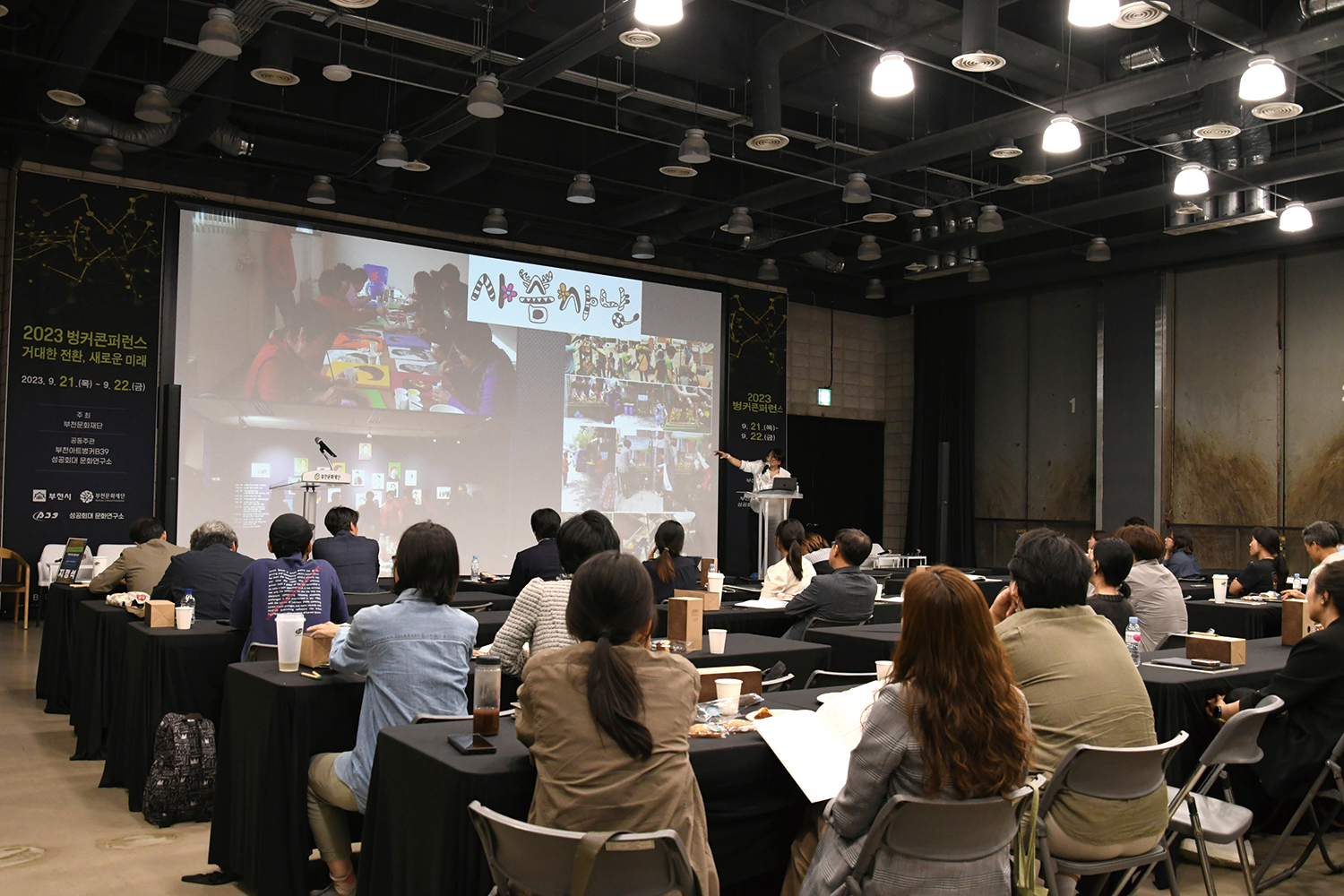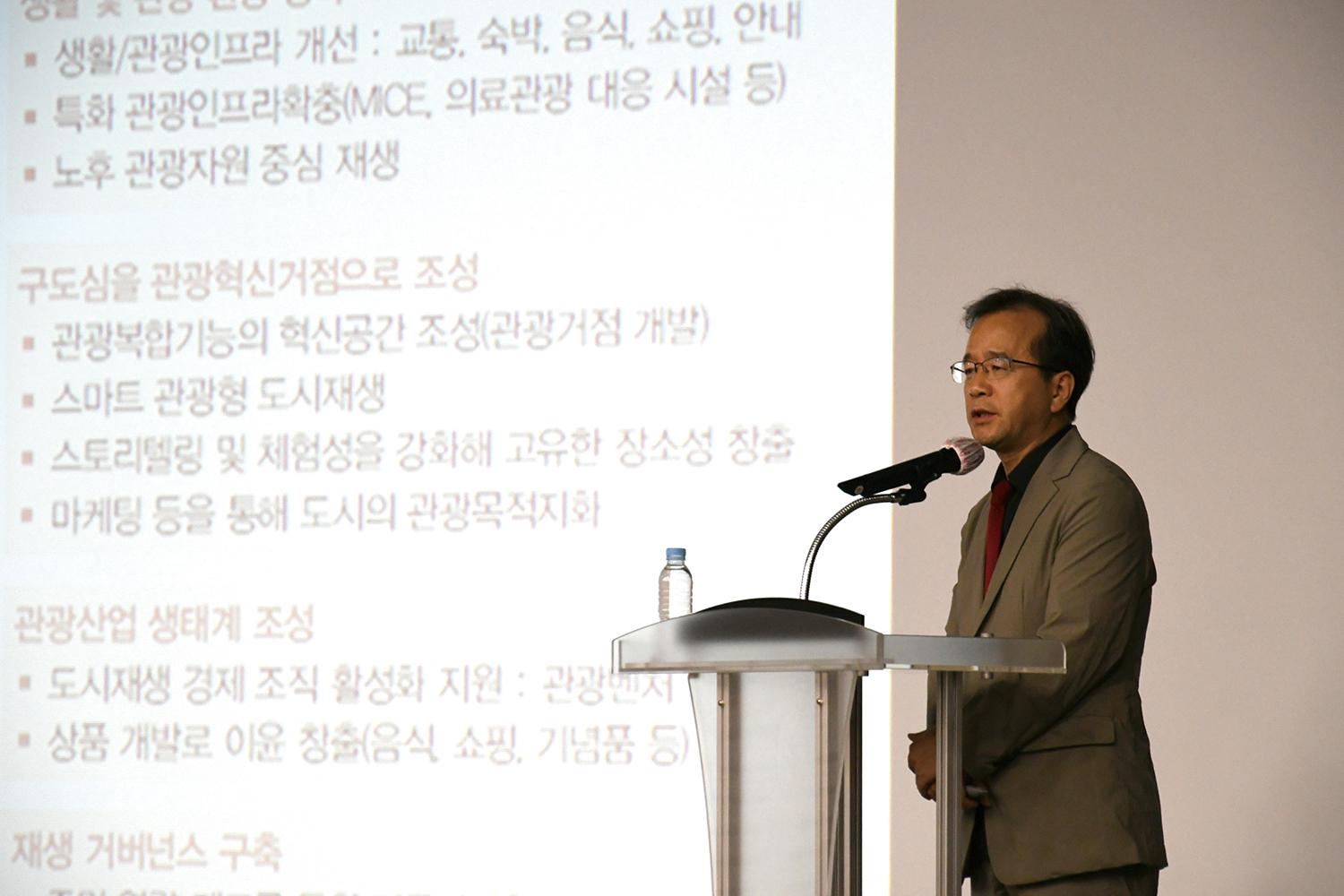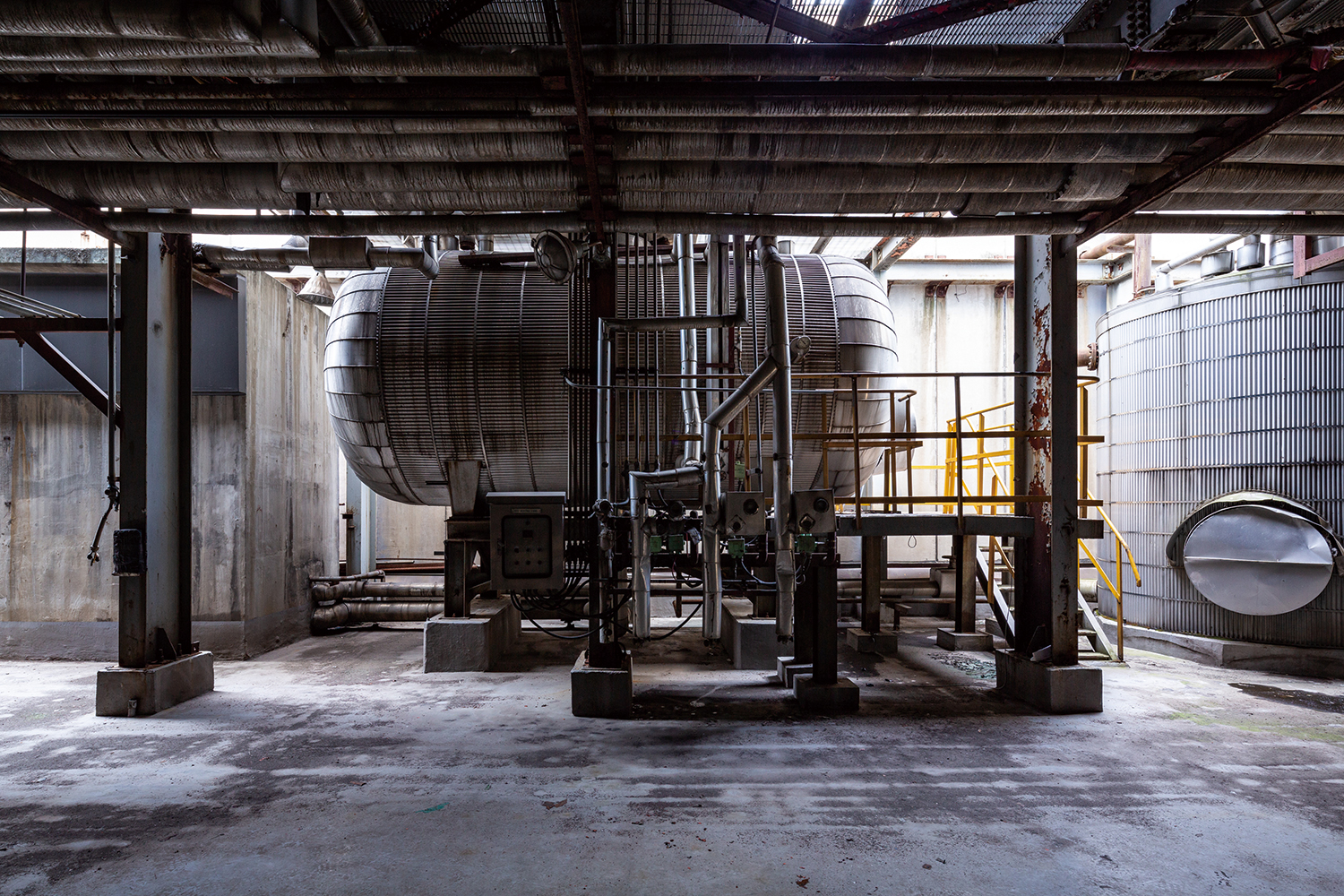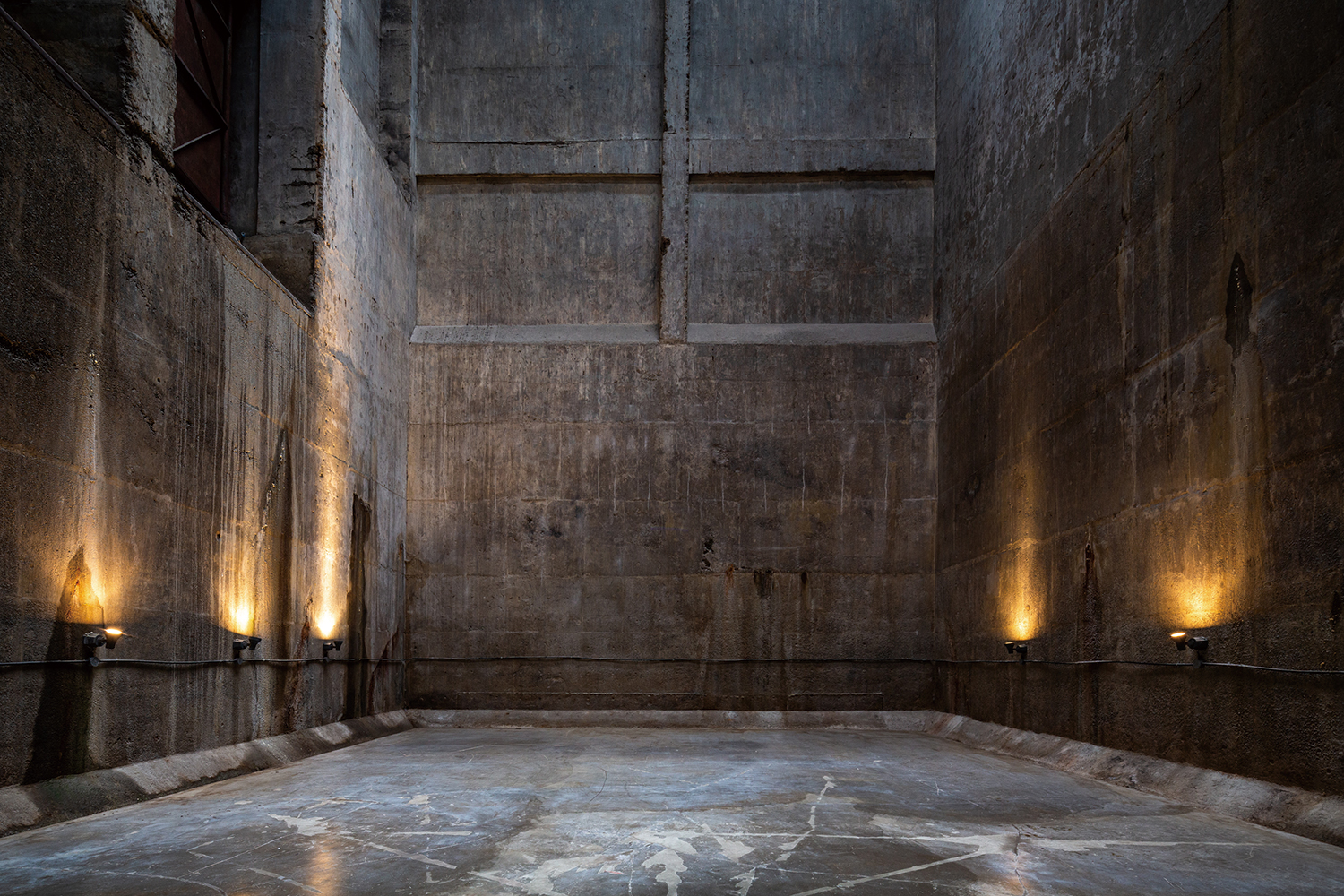SPACE November 2023 (No. 672)

The conference was held at MMH Hall, which was the waste receiving area for the Samjeong-dong incinerator. There are traces of trash left on the right door. / Image courtesy of Bucheon Cultural Foundation

Image of presentation by Jeong Yoonsoo / Image courtesy of Bucheon Cultural Foundation

The condensate tank space remains on the third floor / Image courtesy of Bucheon Cultural Foundation

39m deep bunker / Image courtesy of Bucheon Cultural Foundation
The 2023 Bunker Conference took place on Sep. 21 and 22 in Bucheon Art Bunker B39. It was organised to assess the role that Bucheon Art Bunker B39 has played in the region since opening and to explore and interrogate its future directions. Under the theme, ‘Great Transition, New Future’, the conference brought together urban and architectural experts, local activists, and artists to ask and answer questions about the possibilities for and meaning of Bucheon Art Bunker B39. The event began with a keynote speech by Reigh Youngbum (president, Architecture & Urban Research Institute), followed by presentations and discussions by twelve speakers and panels on four different topics. Reigh said that the future value of industrial heritage lies in considering how the regeneration of abandoned industrial facilities can relate to the changes of today in terms of urban historicity, the placeness in living spaces, the futurity of change and desire, and the continuity of value.
In the first session, Jung Yongsuk (professor, Chuncheon National University of Education), who has been studying the Ruhr region in Germany, presented on the ‘21st Century Cultural Transformation of 20th Century Industrial Heritage’. The Ruhr, a mining region that led industrialisation in Germany from the late nineteenth-century to the end of the 1950s, has been undergoing deindustrialisation due to changes in the industrial ecosystem. As such, attempts have been made to regenerate the city using the abandoned industrial facilities. Examples of such projects, transforming former industrial facilities into cultural assets, can be found not only throughout Germany, but also throughout Europe and Asia, including in Korea. For this presentation, the speaker focused on the foundation and process of using abandoned industrial facilities to enable citywide regeneration. At the time, the state promoted the long-term industrial policy to not only attract alternative industries following the closure of the mining industry, but also to restore the environment polluted by facilities such as coal mines and thermal power plants, and the process required an ecological approach in addition to an economic one. In response, the idea of industrial restructuring was expanded from traditional industries to high technology, ecology, and culture, and the idea of urban regeneration drawing on aspects of industrial heritage was introduced to promote the spatial development of former industrial areas. The state has been implementing long-term policies based on this perspective from the 1980s to the present. For example, the Zeche Zollverein coal mine was designated as a UNESCO World Heritage Site in 2001 after a large-scale regional revitalisation project. The speaker encouraged us to consider what could be done with relics of our industrial heritage in the post-industrial era in association with local government through the given example of the Ruhr region.
The second session, titled ‘The Cultural Regeneration of Industrial Legacy and Local Governance’, featured a discussion about how to revitalise local cultural spaces based on a presentation by Na Dosam (senior research fellow, Seoul Institute). Na emphasised the importance of regional governance, stressing that the capacity of the local cultural and artistic ecosystem and the private-public partnerships based around it are crucial for the production of physical spaces that lead to cultural regeneration. According to this presentation, there is a marked and significant difference between a more simple approach to using industrial heritage and planning based on cultural motivations, as many projects in Korea focus on recycling modern facilities as opposed to progressing based on cultural motivations. Na states that greater social imagination is needed to revitalise such facilities. However, he points out that for all the discourse on the development of governance in Korea, the implementation skills and institutional conditions are currently insufficient. Therefore, it was made clear that institutionalisation and legislation must precede the governance of industrial heritage.
In the third session, Jeong Yoonsoo (professor, Sungkonghoe University) spoke about ‘The Authenticity of Tourism and the Future Value of the Bucheon Art Bunker B39’. Throughout the process of cultural urban regeneration, local governments across the country face the problem of making the revitalisation of the tourism industry a short-term goal rather than a long-term aim and this has produced atomised results. The presentation highlighted the possibilities for cultural spaces such as Bucheon Art Bunker B39 in terms of urban tourism, industrial heritage tourism, and educational tourism from various angles. Kang Gyeonghwan (planner, Village Hotel), who has led the Village Hotel project in Gohan-eup, Jeongseon-gun, Gangwon-do and Kim Dongbeom (advisor, Gimpo Cultural City), who has developed cultural city projects in Gongju-si and Dangjin-si, Chungcheongnam-do, Dobong-gu, Seoul and Gimpo-si also participated in the discussion. They suggested that industrial heritage can only serve as a true tourist resource when it exists the intersection of preserving both a sense of urban place and memory.
Finally, at the fourth session, the theme ʻThe Sustainability of the Bucheon Art Bunker B39, and the Local Cultural Ecology’ was explored, encompassing some elements of the previous three topics and explored the present and future of Bucheon Art Bunker B39. Lee Hunhui (principal, Artforumrhee), who has been actively involved in the local cultural ecosystem in Bucheon for a long time, presented concrete strategies on how Bucheon Art Bunker B39 can play a role as a cultural space in Bucheon. Reflecting the identity of a facility that used to be an incineration plant in the past, he aims to concretise its character by focusing on domestic cultural technology, making it a space for artistic experimentation and research. He suggests establishing a network of domestic and international projects where industrial heritage is reborn as a cultural arts space, sharing the urban regeneration process. Furthermore, he suggests providing continuous art programmes for citizens and promoting the development of art professionals through educational and training institutions. In fulfilling these roles and functions, it is predicted that Bucheon Art Bunker B39 will be able to expand cultural and arts offerings by collaborating with various industries in Bucheon, interacting with citizens, and establishing itself as a sustainable space.





